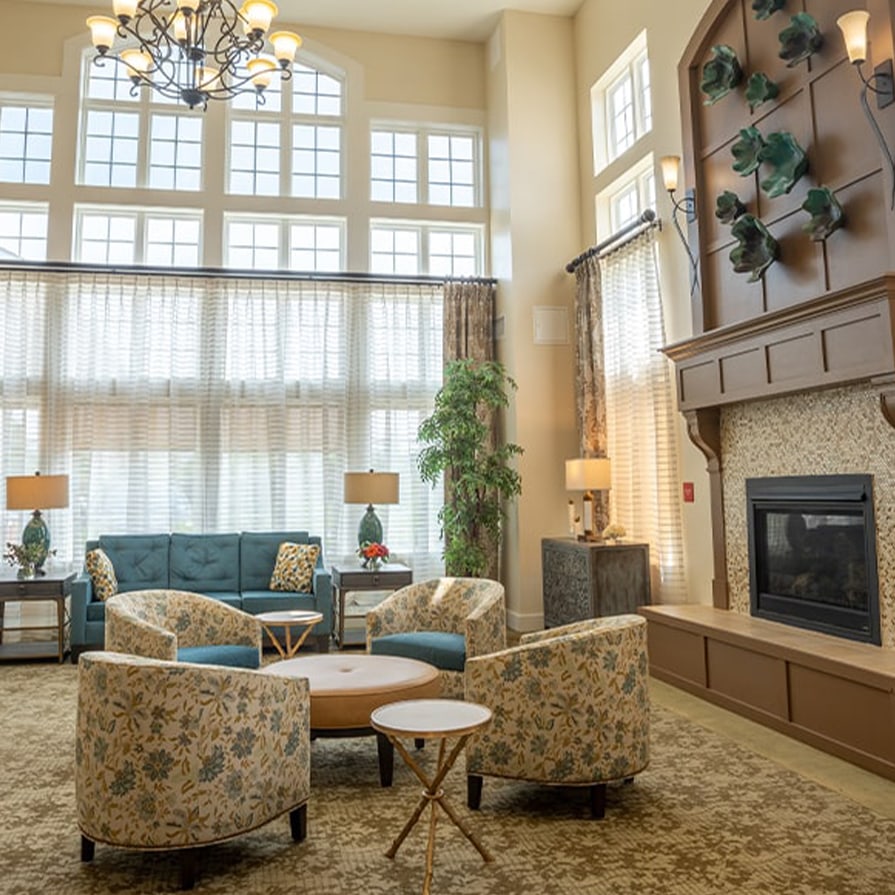Memory care is a specialized form of long-term care tailored to meet the unique needs of individuals living with Alzheimer’s disease, dementia, and other cognitive impairments. Designing safe and engaging environments for memory care residents is paramount to their quality of life, promoting both physical safety and mental stimulation.
At Juniper Village at Brookline, we understand the unique challenges individuals living with memory impairments face. Our specialized memory care program is designed to provide a safe, nurturing, and stimulating environment that promotes cognitive health and overall well-being.
Understanding the Needs of Memory Care Residents
Before delving into the specifics of creating an ideal environment, it’s essential to understand the unique challenges faced by memory care residents. These include:
Cognitive Decline
Cognitive decline is a hallmark of Alzheimer’s disease and dementia. Over time, residents may experience varying degrees of memory loss, confusion, and difficulty with problem-solving. This decline can make it challenging for them to manage daily tasks such as dressing, eating, and personal hygiene.
Recognizing familiar surroundings, people, and objects can become increasingly difficult as well, leading to feelings of disorientation and frustration. Creating an environment that supports cognitive function through routine, clear instructions, and familiar cues is important for their well-being.
Disorientation & Agitation
Many memory care residents exhibit disoriented behaviors, often due to the impulse to find something familiar. This can pose significant safety risks, including the potential for falls, getting lost, or inadvertently entering unsafe areas.
Additionally, residents may experience agitation and anxiety, stemming from confusion or unmet needs. This agitation can manifest in restlessness, repetitive movements, or vocal expressions of distress. Therefore, it is essential to design secure yet soothing spaces that allow for safe exploration while minimizing triggers for anxiety.
Sensory Sensitivity
Individuals with dementia often have heightened sensitivity to sensory stimuli. Noises that might be ignored by others can become overwhelming, bright lights can cause discomfort, and certain textures may be either soothing or irritating.
Sensory sensitivities can significantly influence a resident’s comfort and behavior, making it important to create environments that carefully consider these factors. Calming colors, soft lighting, and controlled sound environments can help reduce sensory overload and promote relaxation.
Emotional & Social Needs
Beyond physical and cognitive challenges, memory care residents also face emotional and social needs. Feelings of isolation and loneliness are common, particularly when cognitive decline limits their ability to engage in meaningful social interactions. Social engagement is important for emotional well-being, and creating opportunities for residents to interact with staff, peers, and family members can greatly enhance their quality of life.
Key Elements of a Safe Environment
Secure Layout & Design
- Secure Access: Make sure that all entrances and exits are secure. Use keypads or other controlled access systems to regulate who enters and leaves the community.
- Clear Signage: Use large, clear signs with images and text to guide residents throughout the community. Color-coded pathways can also help residents navigate more easily.
- Unobtrusive Security: Install unobtrusive security measures like motion sensors and alarm systems to monitor resident movement without creating a restrictive atmosphere.
Fall Prevention
- Non-Slip Flooring: Opt for non-slip flooring materials and make sure that all rugs and mats are securely fastened to avoid tripping hazards.
- Proper Lighting: Adequate lighting is crucial. Use soft, evenly distributed lighting to minimize shadows and glare, which can disorient residents.
- Handrails and Grab Bars: Install handrails in hallways and grab bars in bathrooms to provide extra support and reduce the risk of falls.
Emergency Preparedness
- Accessible Emergency Buttons: Place emergency call buttons in easily accessible locations throughout the facility.
- Staff Training: Regularly train staff on emergency procedures and ensure they are familiar with each resident’s specific needs and medical conditions.

Creating an Engaging Environment
Cognitive Stimulation
- Activity Rooms: Designate areas for activities such as puzzles, board games, and arts and crafts. These activities can help stimulate cognitive function and provide a sense of accomplishment.
- Memory Stations: Create memory stations with items from different eras, such as photographs, music, and memorabilia, to trigger memories and encourage storytelling.
Sensory Engagement
- Sensory Gardens: Develop outdoor sensory gardens with a variety of plants, textures, and scents to offer a calming and engaging experience.
- Multisensory Rooms: Implement multisensory rooms with gentle lighting, soothing sounds, and tactile experiences to provide comfort and reduce anxiety.
Social Interaction
- Common Areas: Design inviting common areas where residents can socialize and interact. Comfortable seating arrangements and communal dining areas encourage group activities and foster a sense of community.
- Pet Therapy: Incorporate pet therapy sessions, as interaction with animals has been shown to reduce stress and improve mood among memory care residents.
Personalized Spaces
- Individual Rooms: Personalize residents’ rooms with familiar objects, photographs, and decorations from their past to create a sense of familiarity and comfort.
- Life Story Boards: Use life story boards outside each resident’s room to highlight personal achievements, interests, and memories, allowing staff and visitors to connect with them on a deeper level.
The Path to Enhanced Well-Being Starts at Juniper
Creating safe and engaging environments for memory care residents requires a thoughtful blend of safety measures and stimulating activities.
By focusing on secure design elements, cognitive and sensory engagement, and social interaction, caregivers can significantly enhance the quality of life for individuals living with cognitive impairments. Ultimately, these environments protect residents and nurture their well-being, providing a supportive and enriching space for them to thrive.
At Juniper Village at Brookline, we are dedicated to providing a secure and enriching environment for our memory care residents. Our thoughtfully designed spaces, personalized care plans, and engaging activities ensure your loved ones receive the best possible support and attention.
Experience our compassionate approach to memory care by scheduling a visit today. Contact us to learn more about how we can make a positive difference in the lives of your family members. Take the first step towards enhanced well-being for your loved ones.







